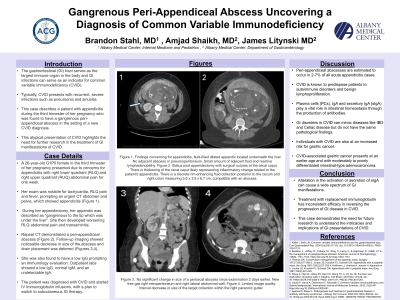Monday Poster Session
Category: Colon
P2084 - Gangrenous Peri-Appendiceal Abscess Uncovering a Diagnosis of Common Variable Immunodeficiency
Monday, October 28, 2024
10:30 AM - 4:00 PM ET
Location: Exhibit Hall E

Has Audio

Brandon Stahl, MD
Albany Medical Center
Albany, NY
Presenting Author(s)
Award: Presidential Poster Award
Brandon Stahl, MD, Amjad Shaikh, MD, James Litynski, MD
Albany Medical Center, Albany, NY
Introduction: The gastrointestinal (GI) tract serves as the largest immune organ in the body and GI infections can serve as an indicator for common variable immunodeficiency (CVID). Typically, CVID presents with recurrent, severe infections such as pneumonia and sinusitis. This case describes a patient with appendicitis during the third trimester of her pregnancy who was found to have a gangrenous peri-appendiceal abscess in the setting of a new CVID diagnosis. This atypical presentation of CVID highlights the need for further research in the treatment of GI manifestations of CVID.
Case Description/Methods: A 26-year-old G1P0 female in the third trimester of her pregnancy presented due to concerns for appendicitis with right lower quadrant (RLQ) and right upper quadrant (RUQ) abdominal pain for one week. Her exam was notable for tachycardia, RLQ pain and fever, prompting an urgent CT abdomen and pelvis, which showed appendicitis (Figure 1). During her appendectomy, her appendix was described as “gangrenous to the tip which was under the liver”. She then developed worsening RLQ abdominal pain and transaminitis. Repeat CT demonstrated a peri-appendiceal abscess (Figure 2). Follow-up imaging showed noticeable decrease in size of the abscess and drain placement was deferred (Figures 3,4). She was also found to have a low IgG prompting an Immunology evaluation. Outpatient labs showed a low IgG, normal IgM, and an undetectable IgA. The patient was diagnosed with CVID and started IV Immunoglobulin infusions, with a plan to switch to subcutaneous IG therapy.
Discussion: CVID is known to predispose patients to autoimmune disorders and benign lymphoproliferation. Plasma cells (PCs), IgA and secretory IgA (sIgA) play a vital role in intestinal homeostasis through the production of antibodies. Alteration in the activation or secretion of sIgA can cause a wide spectrum of GI manifestations. GI disorders in CVID can mimic diseases like IBD and Celiac disease but do not have the same pathological findings. Treatment with replacement immunoglobulin has inconsistent efficacy in reversing the progression of GI disease in CVID. Individuals with CVID are also at an increased risk for gastric cancer. CVID-associated gastric cancer presents at an earlier age and with moderately to poorly differentiated intestinal-type adenocarcinoma. This demonstrates the need for future research to understand the intricacies and implications of GI presentations of CVID.

Disclosures:
Brandon Stahl, MD, Amjad Shaikh, MD, James Litynski, MD. P2084 - Gangrenous Peri-Appendiceal Abscess Uncovering a Diagnosis of Common Variable Immunodeficiency, ACG 2024 Annual Scientific Meeting Abstracts. Philadelphia, PA: American College of Gastroenterology.
Brandon Stahl, MD, Amjad Shaikh, MD, James Litynski, MD
Albany Medical Center, Albany, NY
Introduction: The gastrointestinal (GI) tract serves as the largest immune organ in the body and GI infections can serve as an indicator for common variable immunodeficiency (CVID). Typically, CVID presents with recurrent, severe infections such as pneumonia and sinusitis. This case describes a patient with appendicitis during the third trimester of her pregnancy who was found to have a gangrenous peri-appendiceal abscess in the setting of a new CVID diagnosis. This atypical presentation of CVID highlights the need for further research in the treatment of GI manifestations of CVID.
Case Description/Methods: A 26-year-old G1P0 female in the third trimester of her pregnancy presented due to concerns for appendicitis with right lower quadrant (RLQ) and right upper quadrant (RUQ) abdominal pain for one week. Her exam was notable for tachycardia, RLQ pain and fever, prompting an urgent CT abdomen and pelvis, which showed appendicitis (Figure 1). During her appendectomy, her appendix was described as “gangrenous to the tip which was under the liver”. She then developed worsening RLQ abdominal pain and transaminitis. Repeat CT demonstrated a peri-appendiceal abscess (Figure 2). Follow-up imaging showed noticeable decrease in size of the abscess and drain placement was deferred (Figures 3,4). She was also found to have a low IgG prompting an Immunology evaluation. Outpatient labs showed a low IgG, normal IgM, and an undetectable IgA. The patient was diagnosed with CVID and started IV Immunoglobulin infusions, with a plan to switch to subcutaneous IG therapy.
Discussion: CVID is known to predispose patients to autoimmune disorders and benign lymphoproliferation. Plasma cells (PCs), IgA and secretory IgA (sIgA) play a vital role in intestinal homeostasis through the production of antibodies. Alteration in the activation or secretion of sIgA can cause a wide spectrum of GI manifestations. GI disorders in CVID can mimic diseases like IBD and Celiac disease but do not have the same pathological findings. Treatment with replacement immunoglobulin has inconsistent efficacy in reversing the progression of GI disease in CVID. Individuals with CVID are also at an increased risk for gastric cancer. CVID-associated gastric cancer presents at an earlier age and with moderately to poorly differentiated intestinal-type adenocarcinoma. This demonstrates the need for future research to understand the intricacies and implications of GI presentations of CVID.

Figure: Figure 1. Findings concerning for appendicitis, fluid-filled dilated appendix located underneath the liver. No adjacent abscess or pneumoperitoneum. Small amount of adjacent fluid and reactive lymphadenopathy.
Figure 2. Status post appendectomy with surgical sutures at the cecal caput. There is thickening of the cecal caput likely representing inflammatory change related to the patient's appendicitis. There is a discrete rim-enhancing fluid collection posterior to the cecum and right colon measuring 3.6 x 3.9 x 6.7 cm, compatible with an abscess.
Figure 3. No significant change in size of a pericecal abscess since examination 2 days earlier. New free gas right retroperitoneum and right lateral abdominal wall.
Figure 4. Limited image quality. Interval decrease in size of the target collection within the right paracolic gutter.
Figure 2. Status post appendectomy with surgical sutures at the cecal caput. There is thickening of the cecal caput likely representing inflammatory change related to the patient's appendicitis. There is a discrete rim-enhancing fluid collection posterior to the cecum and right colon measuring 3.6 x 3.9 x 6.7 cm, compatible with an abscess.
Figure 3. No significant change in size of a pericecal abscess since examination 2 days earlier. New free gas right retroperitoneum and right lateral abdominal wall.
Figure 4. Limited image quality. Interval decrease in size of the target collection within the right paracolic gutter.
Disclosures:
Brandon Stahl indicated no relevant financial relationships.
Amjad Shaikh indicated no relevant financial relationships.
James Litynski indicated no relevant financial relationships.
Brandon Stahl, MD, Amjad Shaikh, MD, James Litynski, MD. P2084 - Gangrenous Peri-Appendiceal Abscess Uncovering a Diagnosis of Common Variable Immunodeficiency, ACG 2024 Annual Scientific Meeting Abstracts. Philadelphia, PA: American College of Gastroenterology.

